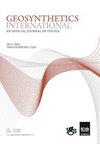静循环荷载下土工格室加筋床:土壤密度和粒度的影响
IF 3.3
2区 工程技术
Q2 ENGINEERING, GEOLOGICAL
引用次数: 2
摘要
本文报道了在试验坑中的弱无筋砂床上进行的一系列静态和循环板荷载试验。软弱的沙子被一层160毫米厚的层覆盖,该层由三种压实土壤类型中的一种组成,这些土壤类型要么是未加固的,要么是土工格室加固的。目的是研究土壤密度和粒度作为覆盖层填料的影响。三种覆盖土为颗粒状,平均粒径分别为2.2(土壤1)、6.14(土壤2)和8.47(土壤3)mm。在静载荷下,当上部无筋土层的平均粒径从2.20 mm变为8.47 mm时,支承压力平均增加23%。由于使用了填土土工格室,支承压力提高了约37%,与未加固的情况不同,采用较大的土壤颗粒填充土工格室袋并没有显示出显著的进一步改善。对于循环荷载试验,采用土工格室层的土壤1的最大沉降减少量约为50%。无论是静态加载还是循环加载,增加土壤密度对于提高土工格室性能可能比使用粒径较大的土壤更有效。本文章由计算机程序翻译,如有差异,请以英文原文为准。
Geocell-reinforced bed under static and cyclic loads: Effect of soil density and grain size
This paper reports on a series of static and cyclic plate loading tests performed on a weak unreinforced sand bed in a test pit. The weak sand was covered by a 160 mm thick layer comprised of one of three compacted soil types which was either unreinforced or geocell-reinforced. The purpose was to investigate the effects of soil density and grain size as filler materials for the covering layer. The three covering soils were granular with average particle sizes of 2.2 (Soil 1), 6.14 (Soil 2), and 8.47 (Soil 3) mm. Under static loading, the bearing pressure increased on average 23% when the average grain size of the upper, unreinforced, soil layer changed from 2.20 mm to 8.47 mm. The improvement in bearing pressure was about 37% due to the use of a soil-filled geocell but, unlike the unreinforced situation, employing larger soil grains to fill the geocell pockets didn't show significant further improvement. For cyclic loading tests, the maximum settlement reduction by employing a geocell layer was about 50% for Soil 1. Whether loaded statically or cyclically, increasing soil density likely would be more efficient for improving geocell performance than by employing a soil having larger particle sizes.
求助全文
通过发布文献求助,成功后即可免费获取论文全文。
去求助
来源期刊

Geosynthetics International
ENGINEERING, GEOLOGICAL-GEOSCIENCES, MULTIDISCIPLINARY
CiteScore
6.90
自引率
20.00%
发文量
91
审稿时长
>12 weeks
期刊介绍:
An online only, rapid publication journal, Geosynthetics International – an official journal of the International Geosynthetics Society (IGS) – publishes the best information on current geosynthetics technology in research, design innovation, new materials and construction practice.
Topics covered
The whole of geosynthetic materials (including natural fibre products) such as research, behaviour, performance analysis, testing, design, construction methods, case histories and field experience. Geosynthetics International is received by all members of the IGS as part of their membership, and is published in e-only format six times a year.
 求助内容:
求助内容: 应助结果提醒方式:
应助结果提醒方式:


